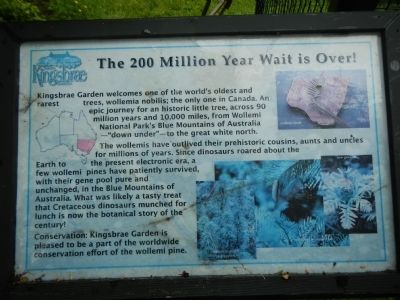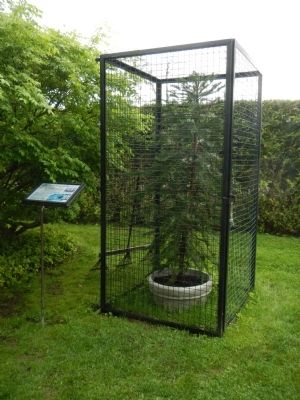St. Andrews in Charlotte County, New Brunswick — The Atlantic Provinces (North America)
The 200 Million Year Wait is Over!
The wollemis have outlived their prehistoric cousins, aunts and uncles for millions of years. Since dinosaurs roared about the Earth to the present electronic era, a few wollemi pines have patiently survived with their gene pool pure and unchanged, in the Blue Mountains of Australia. What was likely a tasty treat that Cretaceous dinosaurs munched for lunch is now the botanical story of the century!
Conservation: Kingsbrae Garden is pleased to be part of the worldwide conservation effort of the wollemi pine.
Erected by Kingsbrae Horticultural Garden.
Topics. This historical marker is listed in this topic list: Horticulture & Forestry.
Location. 45° 4.771′ N, 67° 2.913′ W. Marker is in St. Andrews, New Brunswick, in Charlotte County. Marker can be reached from King Street close to Prince of Wales Street. Touch for map. Marker is at or near this postal address: 204 King Street, St Andrews NB E5B 1R3, Canada. Touch for directions.
Other nearby markers. At least 8 other markers are within walking distance of this marker. Task Force Afghanistan (about 120 meters away, measured in a direct line); Greenock Church / L’Église Greenock (approx. half a kilometer away); St. Andrews Historic District (approx. 0.7 kilometers away); Lest We Forget (approx. 0.8 kilometers away); St. Croix River (approx. 0.8 kilometers away); Blockhouse 101 (approx. 1.1 kilometers away); War of 1812: Defending St. Andrews (approx. 1.1 kilometers away); Two hundred years and counting (approx. 1.1 kilometers away). Touch for a list and map of all markers in St. Andrews.
More about this marker. The Wollemi Pine is located near the Kingsbrae Garden cafe.
Also see . . . Wollemia - Wikipedia. The discovery, on or about 10 September 1994, by David Noble, a field officer of the Wollemi National Park in Blackheath, in the Blue Mountains, only occurred because of his adventurous bushwalking and rock climbing abilities. Noble had good botanical knowledge, and quickly recognised the trees as unusual and worthy of further investigation. Returning with specimens, and expecting someone to be able to identify the plants, Noble soon found that they were new to science. (Submitted on September 23, 2014, by Barry Swackhamer of Brentwood, California.)
Credits. This page was last revised on June 16, 2016. It was originally submitted on September 23, 2014, by Barry Swackhamer of Brentwood, California. This page has been viewed 390 times since then and 12 times this year. Photos: 1, 2. submitted on September 23, 2014, by Barry Swackhamer of Brentwood, California. • Andrew Ruppenstein was the editor who published this page.

